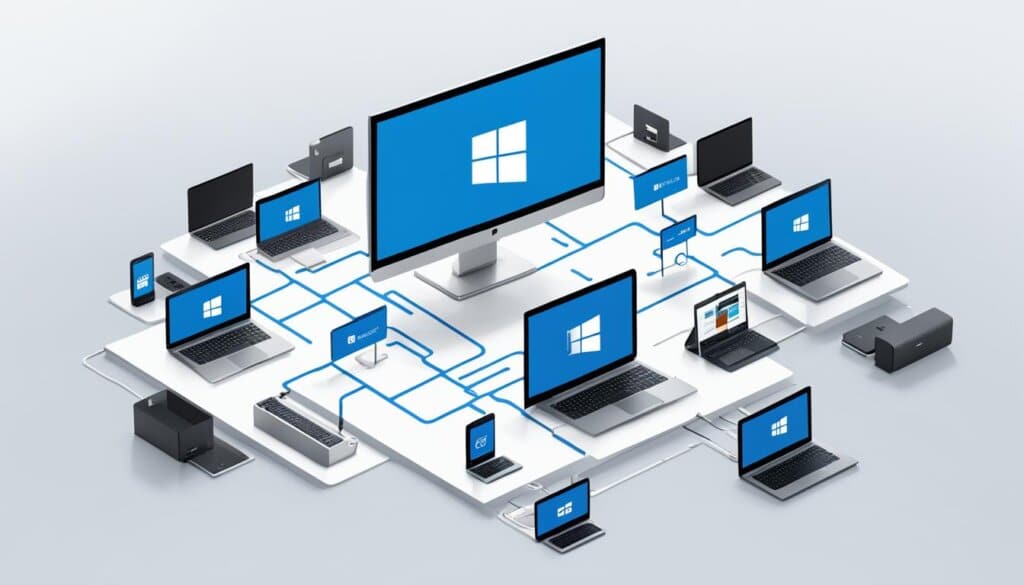Table of Contents
Microsoft Intune is a cloud-based endpoint management solution offered by Microsoft. It enables organizations to effectively manage and secure the devices that access their resources. With Intune, businesses can manage user access, simplify app and device management, and ensure data protection across a variety of devices, including mobile devices, desktop computers, and virtual endpoints.
Intune allows organizations to protect access and data on both company-owned and personal devices, making it a flexible solution for modern workplaces. Additionally, it offers compliance and reporting features that support the Zero Trust security model, ensuring comprehensive endpoint security.
To understand the key features and benefits of Intune, read on to the next section.
Key Features and Benefits of Intune
Microsoft Intune offers a range of powerful features and benefits that make it an essential tool for effective device management, app management, and more. Let’s explore some of the key features and benefits in detail:
1. Device Management
- Manage users and devices, including organization-owned and personally owned devices.
- Supports various platforms such as Android, iOS, Linux Ubuntu Desktop, macOS, and Windows client devices.
2. App Management
- Simplify app management with a built-in app experience.
- Effortlessly deploy, update, and remove apps as needed.
3. Automated Policy Deployment
- Create policies for apps, security, device configuration, compliance, and conditional access.
- Automate the deployment of these policies, saving time and ensuring consistency.
4. Self-Service Features
- Empower employees and students with self-service capabilities through the Company Portal app.
- Perform tasks such as resetting PIN/password, installing apps, and joining groups.
5. Enhanced Endpoint Security
- Integrate with mobile threat defense services like Microsoft Defender for Endpoint.
- Utilize third-party partner services for additional endpoint security.
6. Web-Based Admin Center
- Efficiently manage endpoints through a user-friendly web-based admin center.
- Gather valuable insights through data-driven reporting capabilities.
7. Integration with Microsoft Services
- Seamlessly integrate with other Microsoft services and apps to expand functionality.
- These include Configuration Manager, Windows Autopilot, Endpoint analytics, Microsoft 365, and Microsoft Defender.
With these powerful features and benefits, Microsoft Intune provides organizations with the tools they need to effectively manage devices, streamline app deployment, enhance endpoint security, and integrate with other Microsoft services. It is a comprehensive solution that simplifies device and app management, empowering organizations to achieve their device management goals.
How Microsoft Intune Works
Microsoft Intune is a powerful cloud-based solution that offers comprehensive functionality for mobile device and application management. With Intune, organizations can efficiently manage devices, control data access, deploy applications remotely, and ensure compliance with security policies. Let’s delve into the key aspects of its functionality below.
Policies and Rules for Device Management
Intune enables organizations to define and enforce policies and rules for managing devices. These policies encompass various aspects such as device enrollment, configurations, security settings, and compliance requirements. By implementing specific policies, organizations can ensure consistency and standardization across a range of devices, including smartphones, tablets, and computers.
Controlled Data Access
One of the core features of Intune is its ability to control data access on devices. Organizations can enforce restrictions on data sharing and access permissions based on user roles and device types. This ensures that sensitive company data remains protected and accessible only to authorized individuals, adding an additional layer of security to the overall device management strategy.
Remote Application Deployment and Updates
Intune simplifies the process of deploying and updating applications on managed devices. Administrators can remotely install, update, or remove applications as required, ensuring that users have the latest versions and access to essential business tools. This capability significantly streamlines application management, resulting in improved productivity and reduced administrative overhead.
Self-Service Functionalities
Microsoft Intune offers self-service functionalities through the Company Portal app, which empowers users to perform various tasks independently. Users can reset PINs or passwords, install applications, update device settings, and join user groups—all from a user-friendly interface. This self-service approach reduces dependency on IT support, enabling employees to resolve issues quickly and efficiently.
Integration with Mobile Threat Defense Services
Intune integrates seamlessly with mobile threat defense services to enhance endpoint security. By leveraging services such as Microsoft Defender for Endpoint and third-party partner solutions, Intune can proactively detect and respond to potential threats, ensuring a robust defense against malicious activities. This integration strengthens the overall security posture of the devices managed by Intune.
Web-Based Administration
Intune provides a comprehensive web-based admin center that serves as a centralized hub for device management. Administrators can configure policies, monitor compliance, view reports, and perform various administrative tasks from a single interface. The admin center offers data-driven reporting capabilities, enabling organizations to gain insights and make informed decisions based on real-time information.
Integration with Azure AD and Zero Trust Environment
Intune seamlessly integrates with Azure Active Directory (AD), which enables organizations to implement robust access control policies. This integration enhances the device management capabilities of Intune by leveraging Azure AD’s authentication and authorization functionalities. Combined with a zero-trust security model, Intune ensures that only trusted devices and authorized users can access organizational resources, enhancing overall security and data protection.

Through its comprehensive functionality and seamless integration with other Microsoft services, Microsoft Intune empowers organizations to efficiently manage devices, control data access, and streamline application management. By leveraging the power of the cloud, Intune provides a flexible and scalable solution that caters to the evolving needs of modern organizations.
| Benefits | Challenges |
|---|---|
| Enhanced data security and access control | Initial setup and configuration complexity |
| Increased productivity through efficient app management | User resistance to device management policies |
| Reduced infrastructure management requirements | Technical compatibility issues with certain devices |
| Compliance with data security regulations | Continuous monitoring and enforcement of policies |
| Seamless integration with other Microsoft services | Managing diverse device ecosystems |
Benefits and Challenges of Microsoft Intune
Microsoft Intune offers several benefits that make it a valuable solution for organizations. One of the key advantages is enhanced data security and access control for remote and mobile devices. With Intune, organizations can enforce security policies and protect sensitive data on devices, reducing the risk of data breaches and ensuring compliance with data security regulations.
Another benefit of Intune is increased productivity through effective application management. Organizations can easily deploy, update, and remove apps on a wide range of devices, enabling employees to access the right tools and resources conveniently. Moreover, Intune provides insights into user app usage, allowing organizations to optimize app strategies and improve overall productivity.
Implementing Microsoft Intune also brings the advantage of reduced on-premises infrastructure management. As a cloud-based service, Intune eliminates the need for organizations to maintain and manage complex on-site infrastructure. This not only reduces costs but also streamlines device management processes, making it a more efficient solution.
While Microsoft Intune offers numerous benefits, it also presents some challenges that organizations need to address. One of the key challenges is ensuring comprehensive data security across various devices and platforms. With the increasing number of endpoints, organizations must continuously monitor and manage the security of these devices to protect against potential vulnerabilities and threats.
Moreover, device management can be a challenge, especially when dealing with a diverse fleet of devices running different operating systems. Organizations need to implement effective device management strategies to ensure seamless coordination, efficient updates, and consistent policies across multiple devices.
In conclusion, Microsoft Intune provides significant benefits in terms of data security, productivity, and infrastructure management. However, organizations must carefully consider the challenges associated with data security and device management to maximize the benefits of this powerful cloud-based management solution.
FAQ
What is Microsoft Intune?
Microsoft Intune is a cloud-based endpoint management solution that helps organizations manage the different devices that access organizational resources, including mobile devices, desktop computers, and virtual endpoints.
What are the key features and benefits of Microsoft Intune?
Some key features and benefits of Microsoft Intune include managing users and devices across different platforms, simplifying app management, automating policy deployment, providing self-service features through the Company Portal app, integrating with mobile threat defense services, utilizing a web-based admin center, and integrating with other Microsoft services and apps.
How does Microsoft Intune work?
Microsoft Intune works by providing cloud-based mobile device and application management functionality. It allows organizations to specify policies and rules for devices, control data access, remotely deploy applications and updates, enable self-service functionalities through the Company Portal app, integrate with mobile threat defense services, and utilize a web-based admin center.
What are the benefits and challenges of using Microsoft Intune?
The benefits of using Microsoft Intune include enhanced data security and access control, increased productivity through application management and insights, reduced on-premises infrastructure management, compliance with data security regulations and standards, and integration with other Microsoft products and services. However, organizations may face challenges related to device management and data security when implementing Intune.







